Abstract
Low carbon emissions have a great importance in our life. The increasing importance of carbon emission levels have attracted the interests of researchers and academics in the field. In this article, a panel data econometric model is developed to measure the relationship between renewable energy, energy productivity, population, urbanization, motorization, and Gross Domestic Product (GDP) per capita and their impacts on carbon dioxide CO2 emissions. Data used in this study was collected from the European Statistical Office (EUROSTAT) and five statistical hypotheses were tested and validated through a multilinear regression model using the Econometric Views (Eviews) 10.0 statistical software. The Hausman test was used to choose between a model with fixed effects and a model with random effects, and the variance inflection factor (VIF) was used to test the collinearity between the independent variables. The author’s findings indicate that renewable energy at the European Union (EU) level has a positive impact on low-carbon emissions. It was found that a 1% increase in renewable energy consumption would reduce the CO2 emissions by 0.11 million tons, while population growth and urbanization degree add more restrictions to the econometric equation of the impact on carbon emissions.
1. Introduction
The country members of the United Nations Framework Convention on Climate Change (UNFCCC) agreed to intensify the actions against global warming and combat climate change through an accord to lower the carbon emissions. The Paris Agreement states that each member state should intensify its energy in order to reduce gas emissions, which should provide direct social and economic benefits.
The use of renewable energy generates concerns for central and local governments as well as for researchers to find the optimal solution for fighting against climate change. To achieve a low-carbon environment, the Paris Agreement must be signed and implemented by as many countries as possible.
The main problem in the real world is how to reduce carbon emissions, and one of the possible solutions is increasing the use of renewable energy. Renewable energy sources (RES) are the least expensive options for supporting electricity access by cutting carbon dioxide emissions and reducing air pollution worldwide [1]. The is main issue in the 2030 Agenda for Sustainable Development is universal access to sustainable, reliable, affordable, and renewable energy [2].
Daily activity is burdening our atmosphere with carbon dioxide (CO2) and other global warming emissions. These emissions act like an umbrella for the Earth [3]. In contrast, producing renewable energy results in little to no CO2 emissions. Even when clean energy emissions from life cycles are included, the emissions that are associated with renewable energy are minimal. Therefore, by increasing the levels of RES, CO2 levels would decrease and the global warming emissions levels would be significantly reduced [4].
The aim of this paper is to measure the renewable energy efficiency at the European Union level and its impact on low-carbon emissions for panel data from 28 European Union (EU) countries for a period of eight years, from 2010 to 2017. To attain this goal, an econometric model was estimated with the random Hausman test method, and the data was analyzed using Econometric Views (Eviews) 10.0 statistical software.
This study is structured as followings. Firstly, the evolution of the macroeconomic key factors, relevant for CO2 emissions at the European Union level, are presented and research hypotheses are developed. Then, the multiple linear regression model is estimated using a panel data approach. Finally, the research hypotheses are tested and the results are discussed. Further research, imitations of the study, and final conclusions are summarized in the last section of the paper.
2. Literature Review and Hypotheses Development
According to the experts and researchers, conventional energy sources (coal or fossil fuels) will be exhausted soon. Moreover, the participants at the Paris Agreement Conference of Parties agreed that the time of crude oil energy is over. At the same time, many countries still depend on conventional energy, and carbon dioxide levels are constantly increasing. Hence, the goal of increasing the degree of renewable energy consumption should be a priority for all European Union countries in order to lower their carbon emission levels. Furthermore, increasing renewable energy consumption is in line with the Sustainable Development Goals (SDG) 2030, which were adopted by the most-developed countries.
We note that in line with the Communication on Progress (COP) report [5], the countries agreed to increase investment in renewable energy and make all efforts to lower carbon emissions. Additionally, they agreed to develop, support, and increase production of energy from renewable sources and to minimize the carbon emissions as much as possible.
Previous studies have analyzed the relationship between renewable energy and carbon emissions. Sims et al. [6] conducted an analysis to compare the costs of electricity from several current technologies with future technologies that are expected to be available in the next ten years. The researchers argue that the green energy industry has great potential to reduce CO2 emissions by more than 14% by 2020, as well as having cost reduction benefits compared to the energy actual generation. Other researchers [7] studied the causality process between RES consumption, nuclear energy, and CO2 emissions for the United States in the period of 1960–2007, but they did not reach a point from which an important contribution to carbon reduction could be made.
At the European Union level, some researchers [8] state that to reduce CO2 emissions through increasing the use of RES investments, full attention needs to be paid to the pricing policies and the characteristics of the market of each European Union member state. Other economists [9] revealed that the sale of carbon revenue bonds with maturity at ten years could finance an important share of the initial cost of the project.
In a recent paper [10], the agricultural value added to CO2 emissions was explored, along with the impact of RES consumption in five countries of the Association of Southeast Asian Nations (ASAN). The authors demonstrated that as RES are increasing in ASAN, CO2 emissions in agriculture are decreasing, while non-RES is positively correlated to CO2 emissions. Another study [11] investigated the correlation between these indicators using a dynamic model of investment. The authors indicate that all indicators are useful in attaining a sustainable electricity sector.
The RES sector is developing as a conglomerate category, and thus social relations between technologies and the public are merging. Utilizing prospects from technology and science studies, [12] reveals a few methods in which RES have been implemented in the United Kingdom and how these imply different social organizations and configurations for clean technology. The authors state that a multitude of roles for the consumers are involved across this complex scene, raising questions and cutting across subjects of access, interrelation, differentiation, and meaning.
The cost of CO2 deviation from RES portfolio standards was computed by Johnson [13]. Using the Regulated Product Submissions (RPS) regional requirements deviations, the author estimated the confidence interval of the price elasticity of demand of RES to be (1.69, 3.55) at 95% level of confidence. Using the price elasticity estimation of the demand of RES, the author also computed the deviation of the marginal cost from RPS to be at least $10 USD per CO2 ton, compared to 4 USD per ton of marginal cost of the deviation in the Greenhouse Initiative of Regional Gas.
The kaya identity was introduced in 1997. The indicator was introduced by the authors [14] to express the greenhouse carbon emissions as a product of three other indicators: Gross Domestic Product (GDP) per capita, human population, carbon intensity, and energy intensity. This methodology for analyzing the greenhouse emissions was used by many economists. Li et al. [15] estimated the agricultural CO2 emissions in China between 1995 and 2012 and applied the logarithmic mean divisia index (LMDI) as a technique used for decomposition. Their analyses reveal that the development of the economy impacted a reduction of CO2 emissions in the analyzed period. Other researchers [16] applied the kaya identity to the building sector in Switzerland. The authors demonstrated that after several modernization scenarios, the performance of buildings under investigation could be analyzed against CO2 emission targets. By using LMDI approaches, the role of ecologic industrial parks in reducing CO2 emissions was confirmed, which revealed a reduction of the energy intensity in all South Korean industrial parks [17].
Recent papers have revealed the significant impact of motorization impacts on carbon emissions [18,19,20,21]. The authors argue that the increasing levels of carbon emissions are a direct result of the increasing degree of motorization in well developed countries.
The renewable energy efficiency at the European Union level and its impact on low-carbon emissions have been analyzed in recent studies. Ho et al. [22] explored the vision, the concept, and the cost of the implementation of low-carbon scenarios and examined the policy toward the cut of CO2 emission. This paper also prepared a study on the impact of CO2 emissions in Malaysia. In another study [23], the authors analyzed the correlation between RES and energy efficiency, and their impact on programs of market facilitation. The paper covered a 5-year analysis in RES energy program delivery and development of the market in developing countries. In another study [24], it was revealed that the practices of energy management are still underdeveloped, and it was argued that CO2 emission levels are very low in Malaysian energy markets. The authors argued that the energy efficiency and audits are two important factors for lowering CO2 emissions. The research paper underlines that knowledge, energy awareness, and responsibility are factors of energy efficiency.
All these papers show that while population growth, urbanization degree, and motorization level could increase carbon emission levels, renewables and energy productivity are drivers for decreasing the carbon emission levels at the European Union level.
The novelty of this paper is the panel data regression analysis of the 28 European Union countries, underlining the impact of RES on carbon emissions, and the use of six independent factors that impact CO2 emissions at the European Union level, namely renewable energy, energy productivity, population, urbanization, motorization, and GDP per capita.
Based on the theoretical framework developed in the Introduction, the hypotheses of the research will be further defined. To investigate the impact of exogenous variables on endogenous variables, four statistical hypotheses were developed and are shown in the table below. In Table 1, economic development was used as proxy for a combination of three factors: urbanization, motorization, and GDP per capita. Moreover, since we have more than one exogenous variable in our econometric model, the model will be tested for multicollinearity.

Table 1.
Hypotheses of the research.
We will test and validate the four hypotheses above by using a quantitative model, which will be developed in the following section.
3. Materials and Methods
3.1. Sample Description
In the quantitative analyses, we will use one endogenous variable (emissions of CO2), which was analyzed through a panel of six regressors: renewable energy, energy productivity, population urbanization degree, motorization rate, and real GDP per capita. The indicators are collected from Eurostat for all European Union countries between 2010 and 2017. The panel data econometric model was estimated with Econometric Views (EViews) 10 statistical software.
3.2. Description of the Variables Used in the Econometric Model
The econometric model consists of one dependent variable (Y) and six independent variables (X1–X6). A description of these variables can be seen in Table 2.

Table 2.
Description of variables used in the model.
3.3. The Econometric Model
The correlation between the variables in the model were calculated by Pearson’s coefficient (R):
where E(X), E(Y) represent the means of Y and X, respectively; var(X) and var(Y) are the variances of X and Y, respectively. R takes values in the interval [−1,+1]. If the value of R is close to −1 or +1, we say that the variables are highly (negatively or positively) correlated, and if the value of R is close to 0, then we conclude that the variables are not correlated.
Panel data will be analyzed with an econometric model, and the regression equation [25] is defined as:
where Yi is the exogenous variable; Xi is the endogenous variable; αi, βi are regression coefficients; εit is the residual; i is the cross-section dimension, i = 1, …, 28; and t is the time series dimension, t = 2010, …, 2017.
Further, the Hausman test will used to choose between a model with fixed effects and a model with random effects. It is a test for the correlation between the independent variables and the residuals. The testing hypotheses are:
The Hausman statistic is defined as:
where is the estimator in the model with fixed effects and is the estimator in the model with random effects.
Now, we will perform the Hausman test to choose between a model with random effects and a model with fixed effects. In our case, the random effects (RE) hypothesis is accepted because of its higher efficiency, while the alternative fixed effects (FE) hypothesis is rejected because it is the least consistent.
The variance inflection factor (VIF) test was used to test the collinearity between the independent variables. The VIF test is given by the following formula:
where is the coefficient of determination of the regression equation.
The coefficient of determination is the proportion of the variance in the dependent variable that is predictable from the independent variables. It provides a measure of how well observed outcomes are replicated by the model, based on the proportion of total variation of outcomes explained by the model.
VIF reflects all other factors that influence the uncertainty in the coefficient estimates. A value of VIF close to 1 it means that there is no collinearity, while a value close to 10 implies high collinearity among the independent variables. A cut-off of 5 is commonly used.
The analyses of the results of the quantitative model will be carried out in the next section.
4. Results
4.1. A Description of the Indicators Used in the Model
A short analysis of the variables used in the econometric model could be seen in Figure 1, Figure 2, Figure 3, Figure 4, Figure 5, Figure 6 and Figure 7. Figure 1 presents the evolution of the CO2 emissions in European Union member states from 2010 to 2017.
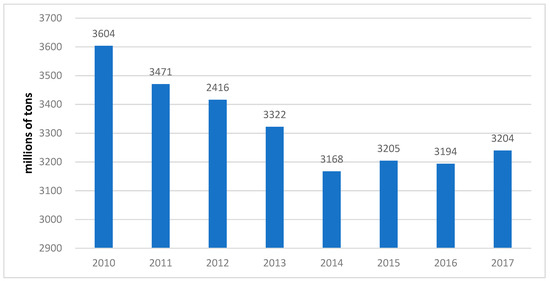
Figure 1.
Total CO2 emissions in millions of tons in European Union member states from 2010 to 2017. Source: Eurostat [26].
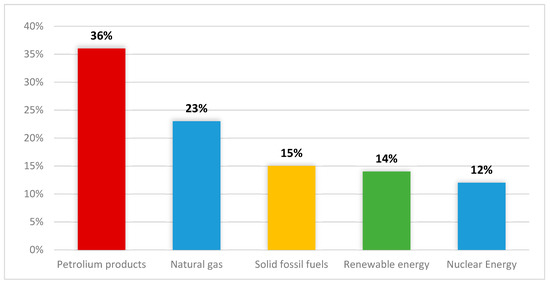
Figure 2.
Energy mix produced in the European Union in 2017. Source: Eurostat [26].
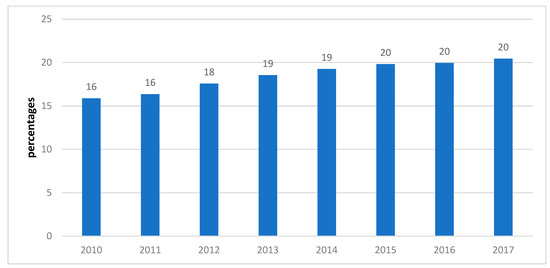
Figure 3.
The average share of renewable energy from the total energy consumed at the European Union level from 2010 to 2017. Source: Eurostat [26].
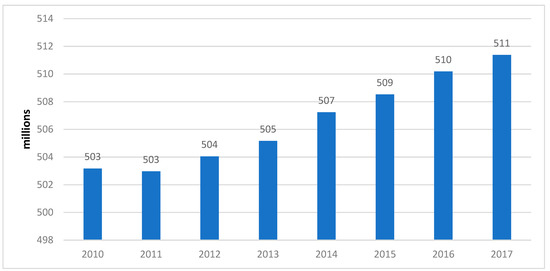
Figure 4.
Level of population in European Union countries, in millions, from 2010 to 2017. Source: Eurostat [26].
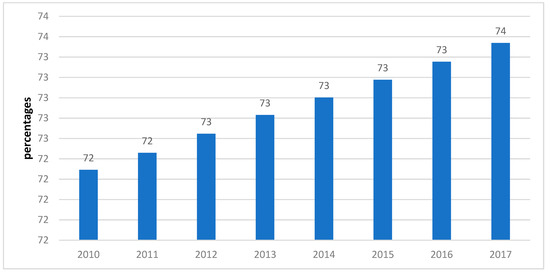
Figure 5.
Urban population rates in European Union countries (% of total) from 2010 to 2017. Source: Eurostat [26].
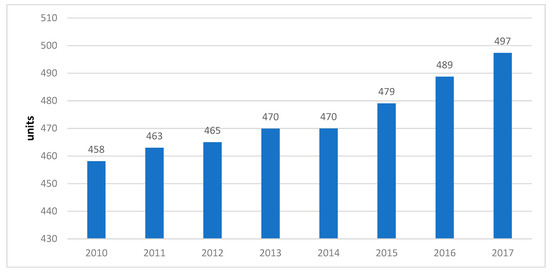
Figure 6.
Average passenger cars per 1000 inhabitants in European Union countries from 2010 to 2017. Source: Eurostat [26].
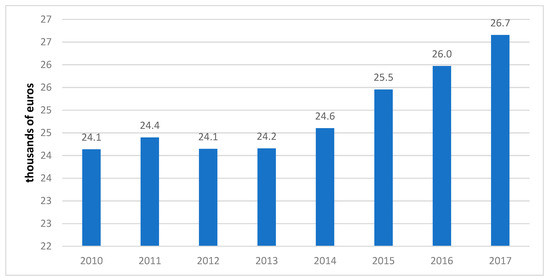
Figure 7.
Average GDP per capita in European Union countries (in thousands of euros) between 2010 and 2017. Source: Eurostat [26].
In the figure above, it can be seen that the total level of emissions of CO2 have decreased from 2010 to 2014 by 11.59%, followed by a small increase from 2014 to 2017 by 2.27%.
According to Eurostat [26], European Union countries imported 55% of the energy consumed, while 45% was produced in the European Union. The energy mix came from five different sources: natural gas, petroleum products, nuclear energy, solid fossil fuels, and renewable energy. In Figure 2, the shares of energy by type in the European Union member states in 2017 are presented.
As can be seen from the figure above, the energy consumed in the European Union came from nuclear energy (12%), renewable energy (14%), solid fossil fuels (15%), natural gas (23%), and petroleum products (36%).
The percentages of renewable energy from the total energy consumed in the European Union member states can be seen in Figure 3.
In Figure 3, we can see that the renewable energy share of total energy showed, on average, an increasing trend. Thus, in 2010 the European Union consumption of renewable energy was about 16% of the total consumption, while in 2017 the renewable energy consumption among European Union countries reached 20% on average, which is a 25% increase.
Another useful indicator directly correlated with the CO2 emission levels is population. In Figure 4, the population levels in European Union member states between 2010 and 2017 can be seen.
As can be seen in Figure 4, the population in European Union countries rose from 511 million in 2010 to 511 million in 2017, which represents a 1.6 increase in the analyzed period.
Another important factor of the CO2 emissions is the level of urbanization. In Figure 5, we can see the levels of urbanization as a percentage of the total population in European Union member states.
In Figure 5, we can see that the urbanization degree increased in the European Union countries from 72% in 2010 to 74% in 2017, which represents a 2.81 increase.
One of the most important indicators, which is directly connected with CO2 emissions, is the motorization in European Union countries. Thus, in Figure 6 we can see the evolution of the number of passenger cars in European Union countries per 1000 inhabitants between 2010 and 2017.
As we can see in the above figure, in European Union countries passenger cars increased from 452 cars per thousand capita to 497 cars per thousand capita, which represents an increase of 8.55%.
Lastly, GDP per capita is an important indicator of CO2 emissions. In Figure 7, we can see the real GDP per capita in European Union countries between 2010 and 2017. Real GDP per capita is used to measure the mean of the national income per person after adjustments for inflation have been made.
In the above figure, we can see that the average GDP in European Union countries was relatively constant from 2010 to 2013, followed by a 10.3% increase from 24,200 euro in 2010 to 26,700 euro in 2017.
4.2. The Econometric Model
A statistical interpretation of the econometric model variables can be seen in the following table. From the measures of the median and mean (measures of central tendency) and standard deviation (measure of variability), we can obtain useful information regarding the distribution of the analyzed variables. If the mean is 10% of the median of the absolute value, then we can assume that the distribution is close to normal [27]. In Table 3, we can see that those values are close to each other for all variables in the model. Thus, it can be concluded that all indicators in our model follow a normal distribution.

Table 3.
A statistical description of the indicators used in the model.
The matrix of correlation between the variables in our model is given in Table 4. The correlation matrix helps us to determine whether there are multicollinearity problems with the model. Dabholkar et al. [28] state that if the coefficients of correlation between the exogenous indicators are within ± 0.30, then there are no multicollinearity problems.

Table 4.
The matrix of correlations.
The correlation matrix reveals that the dependent variable is highly correlated with the independent variables, while the level of correlation between the independent variables is low, as all coefficients of correlation between the exogenous variables are less than ± 0.30. Therefore, it can be stated that the econometric model does not have multicollinearity issues. Moreover, the CO2 emission level is highly correlated with renewable energy (71.2%) and energy productivity (70.5%), while the most correlated independent variables were renewable energy and motorization (27.8%).
For the econometric model estimation, CO2 emission level was the endogenous variable (Y), influenced by 6 exogenous variables (regressors): renewable energy (X1), energy productivity (X2), population (X3), urbanization (X4), motorization (X5), and real GDP per capita (X6). The regression model was estimated in three steps: development of the model, parameter estimation, and verification of results.
The Hausman test was applied to the panel data, modelling the CO2 emissions at the European Union level between 2010 to 2017 in terms of the independent variables of the quantitative model. The results can be seen in Table 5.

Table 5.
Impact of renewable energy, energy productivity, population, urbanization, motorization, and real GDP per capita on CO2 emissions at the European Union level.
Analyzing the results of the Hausman test from the above table, it can be seen that the p-value (probability = 0.0943) is above the threshold value of 0.05. Thus, we conclude that our model is a random effect model. Also, the econometric model is accurate and all exogenous indicators in the model are statistically significant. Moreover, 42.78% of the variation of the total CO2 emissions at the European Union level are described by the independent variables of the model.
The analysis of the results of the estimated coefficients of the econometric model in Table 5 reveals that RES have a significant lowering impact on CO2 emission levels. Thus, a 1% increase in consumption of renewable energy in European Union member states would lead to a 108,000 ton decrease of CO2 emissions. Moreover, each euro/kg increase in energy productivity at the European Union level would lead to a 105,000 ton decrease of CO2 emissions. At the same time, a population increase of 1 million people in the European Union member states would lead to a 112,000 ton increase of CO2 emissions. A 1% increase in the levels of urbanization in European Union countries would increase CO2 emissions by 148,000 tons, a 1 unit increase in motorization degree at the European Union level would lead to a 178,000 million ton increase of CO2 emissions, and if real GDP increased by 1000 euro per capita, then CO2 emissions would increase by 125,000 tons.
VIF was used to test the collinearity between the independent factors. The test results are given in Table 6.

Table 6.
VIF test for collinearity.
From the above table we can see that all the VIF values are below the threshold value of 5, and thus we could conclude that there are no collinearity problems with this model.
Hence, all four statistical hypotheses developed at the end of Section 1 are valid.
5. Discussion of the Results
The impact of renewable energy on carbon emissions has been investigated in many scientific papers in recent years. The econometric model parameters were estimated by the correlated random effects Hausman test and the data were analyzed by the statistical software Eviews 10.0.
Analyzing the CO2 emission levels at the European Union level from 2010 to 2017 using the independent factors, the regression equation resulted from a panel data econometric model (see Table 5): Y = −0.108X1 − 0.105X2 + 0.112X3 + 0.148X4 + 0.178X5 + 0.125X6. Hence, we could conclude that the maximum impact on CO2 emissions was given by the motorization level (coefficient = 0.175), followed by urbanization (coefficient = 0.148) and real GDP per capita (coefficient = 0.118950). Moreover, all six independent variables have significant impacts on CO2 emissions. While renewable energy and energy productivity have negative impacts on the increasing levels of CO2 emissions, population, urbanization, motorization, and GDP per capita have positive impacts on the increasing CO2 emission levels.
The econometric analysis completed in this research paper revealed the measures of the exogenous variables and their impact on the endogenous variable CO2 emissions. Hence, we could make the conclusion that motorization and urbanization have a greater impact on CO2 emission levels than RES have.
Given that the R-squared value is 0.4278, we conclude that 42.78% of the dependent variable’s variation is explained by the variability of the independent variables of the model, and observe that 67.22% of the variability of the dependent variable is determined by other factors not covered by our analysis.
The analysis of the econometric model reveals that the econometric model was analyzed correctly and that renewable energy was a significant factor effecting carbon emissions in all 28 European Union member states, since the estimated regression coefficients were significant and a significant share of the variability of the carbon emissions was determined by the econometric model. Moreover, both the lack of autocorrelation and the collinearity between the exogenous variables prove that there is not a significant juxtaposition among the variables used in the econometric model. These conclusions are consistent with other recent studies [29,30,31,32,33] on the correlation between renewable energy and carbon emission levels.
The results of the study validate the statistical hypotheses that renewable energy, energy productivity, population, urbanization, motorization, and GDP per capita have a strong effect on carbon emissions. This confirms recent studies [34,35,36,37] that state that increasing levels of population and urbanization are leading to higher rates of carbon emissions.
The conclusions of our study are in line with Marques [38], who performed a quantitative analysis to demonstrate the impact of motorization and urbanization levels on CO2 levels in European Union countries. The results of the study are also related with other research papers [39,40], which argue that an important step to reduce the CO2 levels in European Union member states is to invest in renewable energy. The authors underline that energy productivity, renewable energy, and urbanization are significant indicators of sustainable development and help lower CO2 emissions.
Civil and private society actors, as well as local and central governments, should focus their attention on changing policies to achieve a low-carbon environment. A transition to a low-carbon society should be accomplished through governmental programs, grassroots schemes, and with the involvement of civil society.
The statistical analysis of the macroeconomic indicators reveals that there are significant differences between developed and emerging economies within the European Union. Thus, while Western and Nordic European Union countries have excellent results in terms of consumption of RES, the Eastern European states within the European Union still need to increase their RES consumption.
6. Conclusions
The results of the study confirm the hypothesis of the research, according to which the energy productivity has a strong and significant impact on CO2 emissions, which are in line with the European Union allegation that a 10% increase in energy productivity by 2030 may lead to a reduction of carbon emission levels of almost 1%.
The novelty of this paper comes from the regression analysis of the 28 European Union countries using a panel data approach, through which the RES efficiency and its impact on CO2 emissions at the European Union level were analyzed. The quantitative analysis was based on the data collected from Eurostat over a timeframe of 8 years, and hence the main limitation of this research is related to the time series used in the quantitative analysis. Therefore, future studies should be performed for periods of time longer than 8 years, which could lead to a more precise image of the regression model developed for the economic indicators.
Therefore, we can conclude that the panel data regression model for emission levels of CO2 was accurately defined and valid, and the independent variables of population, urbanization, degree of motorization, energy productivity, and RES were significant indicators with impacts on carbon emissions in all European Union member states. This conclusion came from the significant values of the regression coefficients and from the fact that the CO2 emission variability was mostly explained by the variability of the independent variables.
The civil and private sectors, government, and civil society must keep their attention and focus on developing low-carbon policies. While non-state actors and policy makers have underlined the need for better involvement to sustain CO2 reduction, the general public and governments have shown better involvement in programs aimed at reducing air pollution and climate change the past few years.
Funding
This research received no external funding.
Acknowledgments
This work was cofinanced by the European Social Fund through Operational Program Human Capital 2014–2020, project number POCU/380/6/13/125015 “Development of entrepreneurial skills for doctoral students and postdoctoral researchers in the field of economic sciences”.
Conflicts of Interest
The author declares no conflict of interest.
Abbreviations
| EU | European Union |
| RES | Renewable energy systems |
| CO2 | Carbon dioxide |
| GDP | Gross domestic product |
| COP | Communication on Progress |
| RPS | Regulated Product Submissions |
| SDG | Sustainable development goal |
| UNFCCC | United Nations Framework Convention on Climate Change |
| EVIEWS | Econometric Views |
| VIF | Variance Inflection Factor |
| EUROSTAT | Statistical Office of the European Union |
| COP | Conference of Parties |
| LMDI | Logarithmic Mean Divisia Index |
References
- Markandya, A.; Armstrong, B.G.; Hales, S.; Chiabai, A.; Criqui, P.; Mima, S.; Wilkinson, P. Public health benefits of strategies to reduce greenhouse-gas emissions: Low-carbon electricity generation. Lancet 2009, 374, 2006–2015. [Google Scholar] [CrossRef]
- Anderson, K.; Ryan, B.; Sonntag, W.; Kavvada, A.; Friedl, L. Earth observation in service of the 2030 Agenda for Sustainable Development. Geo-Spat. Inf. Sci. 2017, 20, 77–96. [Google Scholar] [CrossRef]
- Mohnen, V.A.; Goldstein, W.; Wang, W.C. The conflict over global warming: The application of scientific research to policy choices. Glob. Environ. Chang. 1991, 1, 109–123. [Google Scholar] [CrossRef]
- Bang, G. Energy security and climate change concerns: Triggers for energy policy change in the United States? Energy Policy 2010, 38, 1645–1653. [Google Scholar] [CrossRef]
- COP 21 Report. 2015. Available online: https://www.gouvernement.fr/en/cop21 (accessed on 25 September 2019).
- Sims, R.E.; Rogner, H.H.; Gregory, K. Carbon emission and mitigation cost comparisons between fossil fuel, nuclear and renewable energy resources for electricity generation. Energy Policy 2003, 31, 1315–1326. [Google Scholar] [CrossRef]
- Menyah, K.; Wolde-Rufael, Y. CO2 emissions, nuclear energy, renewable energy and economic growth in the US. Energy Policy 2010, 38, 2911–2915. [Google Scholar] [CrossRef]
- Kök, A.G.; Shang, K.; Yücel, Ş. Impact of electricity pricing policies on renewable energy investments and carbon emissions. Manag. Sci. 2016, 64, 131–148. [Google Scholar] [CrossRef]
- Tang, A.; Chiara, N.; Taylor, J.E. Financing renewable energy infrastructure: Formulation, pricing and impact of a carbon revenue bond. Energy Policy 2012, 45, 691–703. [Google Scholar] [CrossRef]
- Liu, X.; Zhang, S.; Bae, J. The impact of renewable energy and agriculture on carbon dioxide emissions: Investigating the environmental Kuznets curve in four selected ASEAN countries. J. Clean. Prod. 2017, 164, 1239–1247. [Google Scholar] [CrossRef]
- Fagiani, R.; Richstein, J.C.; Hakvoort, R.; De Vries, L. The dynamic impact of carbon reduction and renewable support policies on the electricity sector. Util. Policy 2014, 28, 28–41. [Google Scholar] [CrossRef]
- Walker, G.; Cass, N. Carbon reduction, the publicand renewable energy: Engaging with socio-technical configurations. Area 2007, 39, 458–469. [Google Scholar] [CrossRef]
- Johnson, E.P. The cost of carbon dioxide abatement from state renewable portfolio standards. Resour. Energy Econ. 2014, 36, 332–350. [Google Scholar] [CrossRef]
- Kaya, Y.; Yokobori, K. (Eds.) Environment, Energy, and Economy: Strategies for Sustainability; United Nations University Press: Tokyo, Japan, 1997. [Google Scholar]
- Li, W.; Ou, Q.; Chen, Y. Decomposition of China’s CO2 emissions from agriculture utilizing an improved Kaya identity. Environ. Sci. Pollut. Res. 2014, 21, 13000–13006. [Google Scholar] [CrossRef] [PubMed]
- Mavromatidis, G.; Orehounig, K.; Richner, P.; Carmeliet, J. A strategy for reducing CO2 emissions from buildings with the Kaya identity—A Swiss energy system analysis and a case study. Energy Policy 2016, 88, 343–354. [Google Scholar] [CrossRef]
- Jung, S.; An, K.J.; Dodbiba, G.; Fujita, T. Regional energy-related carbon emission characteristics and potential mitigation in eco-industrial parks in South Korea: Logarithmic mean Divisia index analysis based on the Kaya identity. Energy 2012, 46, 231–241. [Google Scholar] [CrossRef]
- Tu, M.; Li, Y.; Bao, L.; Wei, Y.; Orfila, O.; Li, W.; Gruyer, D. Logarithmic Mean Divisia Index Decomposition of CO2 Emissions from Urban Passenger Transport: An Empirical Study of Global Cities from 1960–2001. Sustainability 2019, 11, 4310. [Google Scholar] [CrossRef]
- Feng, Y.; Wang, X.; Du, W.; Liu, J. Effects of Air Pollution Control on Urban Development Quality in Chinese Cities Based on Spatial Durbin Model. Int. J. Environ. Res. Public Health 2018, 15, 2822. [Google Scholar] [CrossRef]
- Brand, C.; Goodman, A.; Ogilvie, D.; iConnect Consortium. Evaluating the impacts of new walking and cycling infrastructure on carbon dioxide emissions from motorized travel: A controlled longitudinal study. Appl. Energy 2014, 128, 284–295. [Google Scholar] [CrossRef]
- Schipper, L.; Banerjee, I.; Ng, W.S. Carbon dioxide emissions from land transport in India: Scenarios of the uncertain. Transp. Res. Rec. 2009, 2114, 28–37. [Google Scholar] [CrossRef]
- Ho, C.S.; Matsuoka, Y.; Simson, J.; Gomi, K. Low carbon urban development strategy in Malaysia—The case of Iskandar Malaysia development corridor. Habitat Int. 2013, 37, 43–51. [Google Scholar] [CrossRef]
- Parthan, B.; Osterkorn, M.; Kennedy, M.; Bazilian, M.; Monga, P. Lessons for low-carbon energy transition: Experience from the Renewable Energy and Energy Efficiency Partnership (REEEP). Energy Sustain. Dev. 2010, 14, 83–93. [Google Scholar] [CrossRef]
- Fernando, Y.; Hor, W.L. Impacts of energy management practices on energy efficiency and carbon emissions reduction: A survey of Malaysian manufacturing firms. Resour. Conserv. Recycl. 2017, 126, 62–73. [Google Scholar] [CrossRef]
- Schmidheiny, K. Short Guides to Micro Econometrics: The Multiple Linear Regression Model. 2016. Available online: http://www.schmidheiny. name/teaching/panel2up.pdf (accessed on 24 November 2019).
- Eurostat. Available online: http://ec.europa.eu/eurostat (accessed on 28 September 2019).
- Beaver, W.H.; Clarke, R.; Wright, W.F. The association between unsystematic security returns and the magnitude of earnings forecast errors. J. Account. Res. 1979, 316–340. [Google Scholar] [CrossRef]
- Dabholkar, P.A.; Thorpe, D.I.; Rentz, J.O. A measure of service quality for retail stores: Scale development and validation. J. Acad. Mark. Sci. 1996, 24, 3. [Google Scholar] [CrossRef]
- Busu, M. The Role of Renewables in a Low-Carbon Society: Evidence from a Multivariate Panel Data Analysis at the EU Level. Sustainability 2019, 11, 5260. [Google Scholar] [CrossRef]
- Nguyen Duc, D.; Nananukul, N. Advanced Methodologies for Biomass Supply Chain Planning. Processes 2019, 7, 659. [Google Scholar]
- Zhang, X.; Ao, X.; Cai, W.; Jiang, Z.; Zhang, H. A sustainability evaluation method integrating the energy, economic and environment in remanufacturing systems. J. Clean. Prod. 2019, 239, 118100. [Google Scholar] [CrossRef]
- Ma, M.; Ma, X.; Cai, W.; Cai, W. Carbon-dioxide mitigation in the residential building sector: A household scale-based assessment. Energy Convers. Manag. 2019, 198, 111915. [Google Scholar] [CrossRef]
- Busu, M. Applications of TQM Processes to Increase the Management Performance of Enterprises in the Romanian Renewable Energy Sector. Processes 2019, 7, 685. [Google Scholar] [CrossRef]
- Wang, Q.; Zeng, Y.E.; Wu, B.W. Exploring the relationship between urbanization, energy consumption, and CO2 emissions in different provinces of China. Renew. Sustain. Energy Rev. 2016, 54, 1563–1579. [Google Scholar] [CrossRef]
- Zhu, Q.; Peng, X. The impacts of population change on carbon emissions in China during 1978–2008. Environ. Impact Assess. Rev. 2012, 36, 1–8. [Google Scholar] [CrossRef]
- Busu, M. Assessment of the Impact of Bioenergy on Sustainable Economic Development. Energies 2019, 12, 578. [Google Scholar] [CrossRef]
- Zhang, Y.J.; Liu, Z.; Zhang, H.; Tan, T.D. The impact of economic growth, industrial structure and urbanization on carbon emission intensity in China. Nat. Hazards 2014, 73, 579–595. [Google Scholar] [CrossRef]
- Marques, A.C.; Fuinhas, J.A.; Manso, J.P. Motivations driving renewable energy in European countries: A panel data approach. Energy Policy 2010, 38, 6877–6885. [Google Scholar] [CrossRef]
- D’Adamo, I.; Rosa, P. Current state of renewable energies performances in the European Union: A new reference framework. Energy Convers. Manag. 2016, 121, 84–92. [Google Scholar] [CrossRef]
- EU. Regulation (EC) No 2150/2002 of the European Parliament and the Council on Waste Statistics. 2002. Available online: http://www.kluwerlawonline.com/abstract.php?id=EELR2003019 (accessed on 13 November 2019).
© 2019 by the author. Licensee MDPI, Basel, Switzerland. This article is an open access article distributed under the terms and conditions of the Creative Commons Attribution (CC BY) license (http://creativecommons.org/licenses/by/4.0/).